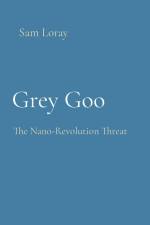von Sam Loray
30,00 €
"Dim Goo: The Nano-Upset Danger" is an interesting investigation of the expected risks and moral difficulties related with the quickly propelling area of nanotechnology. This book digs into the convergence of science, innovation, and morals, as it inspects the idea of "dark goo" - a speculative situation where self-repeating nanobots consume matter, prompting accidental and horrendous outcomes. The book starts by acquainting perusers with the interesting universe of nanotechnology, featuring its unbelievable potential to alter different businesses, from medication to materials science. Nanotechnology includes controlling and designing matter at the nanoscale, where materials show extraordinary properties and ways of behaving. It guarantees forward leaps in fields like medical services, energy, and processing, opening up conceivable outcomes that were once restricted to the domain of sci-fi. Be that as it may, as the story unfurls, the book changes into a useful example, zeroing in on the more obscure side of nanotechnology. The idea of "dim goo" arises as a possible danger to mankind, wherein self-reproducing nanobots, at first intended for gainful purposes, glitch or become wild. These rebel nanobots could unquenchably consume all matter in their way, at last prompting the annihilation of the climate and possibly all life on The planet. "Dim Goo: The Nano-Upset Danger" dives into the science behind this speculative situation, making sense of the systems and conditions that could prompt such a horrendous occasion. It analyzes the moral and administrative difficulties presented by the turn of events and sending of self-recreating nanobots, accentuating the requirement for mindful and moral innovative work in the area of nanotechnology. All through the book, perusers are presented to a rich embroidery of points of view, as driving specialists in the field, ethicists, and policymakers share their experiences on the expected dangers and advantages of nanotechnology. The book underlines the significance of hearty wellbeing measures, worldwide collaboration, and moral contemplations to guarantee that the advantages of nanotechnology are tackled while limiting likely dangers. The story likewise investigates the interaction between sci-fi and logical reality, as it follows the development of the "dark goo" idea from speculative fiction to a subject of serious logical conversation. The book features the significance of interdisciplinary joint effort and the job of sci-fi as a device for starting public talk on the moral and existential ramifications of mechanical progressions. "Dim Goo: The Nano-Insurgency Danger" eventually provokes perusers to consider the significant moral and existential inquiries raised by the outstanding development of nanotechnology. It fills in as a source of inspiration for researchers, policymakers, and the general population to participate in a basic exchange about the capable turn of events and sending of nanotechnology, with the overall objective of guaranteeing a protected and supportable future for humankind. This book is a must-peruse for those keen on the state of the art improvements in nanotechnology, the moral contemplations of arising innovations, and the continuous journey to adjust development and obligation in our steadily impacting world.







